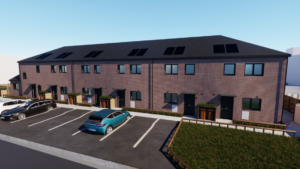How to bridge the digital divide in social housing
 With Leeds City Council recently trialling free internet coverage at two of its tower blocks, Chris Baldock, chairman of 6G Internet, argues that it should be a given for all social housing tenants.
With Leeds City Council recently trialling free internet coverage at two of its tower blocks, Chris Baldock, chairman of 6G Internet, argues that it should be a given for all social housing tenants.
If there was ever a sliver of doubt about how essential the internet is to daily life for the majority of British citizens, it can be quickly addressed with a few simple facts: According to Ofcom, smartphone use has grown to such an extent that 78% of adults now own one, growing to 95% of 16-24 year olds. 74% of UK adults rely on the internet to keep them close to family and friends, with more than a third admitting that they feel ‘cut-off’ without access.
But for low-income households – especially those in social housing, there is a serious risk of being left behind. According to the government’s digital inclusion strategy, approximately 37% of people without a permanent internet connection live in social housing. Working age people in the D and E socio-economic categories are three times as likely to not have access to the internet as others, with 16% of those who do have a connection only able to go online via their smartphone.
These same people are less likely to understand how to get the best from price comparison websites. This is important because it hints at a core disadvantage that affects people on low-incomes when it comes to lack of internet access – it affects their ability to achieve a better quality of life.
Beyond the poverty premium
The University of Bristol found that low-income households pay an extra £490 a year on everyday goods and services as a result of being unable to get the best deals on household energy, insurance, credit, shopping or money. The vast majority of the population solves this problem by going online, where they know they can get the cheapest deals. However, it’s the people without the means or skills to similarly improve their living standards for whom an extra £40 per month would mean the most. If you’re single, under 25 and claiming Universal Credit, it’s the equivalent of a 16% increase on your monthly standard allowance, or about two weeks’ worth of food shopping.
The value of being included in the digital world was quantified in BT’s Valuing Digital Inclusion report in 2014, which found that getting online is worth £1,064 a year to those on the lowest incomes, as a result of increased confidence, less social isolation, improved finances and better job and leisure opportunities. For those already in employment, the chance to increase earnings and work from home makes getting connected even more beneficial – valued at more than £3,500 per year.
But it’s not just about cold, hard cash. A 2016 study by Carnegie UK Trust found that people who use the internet are more likely to have been to a cultural event, visited the outdoors for recreation, taken part in sport and volunteered in the community. The NHS’s Widening Digital Participation programme found that more than half of all patients introduced to online health services would use it for non-urgent medical advice before contacting their GP, explore ways to improve mental health and wellbeing and find more health information, in addition to feeling less lonely and isolated.
The consequences of digital exclusion
While these are all excellent examples of how the internet can improve quality of life, there is a more pressing concern. The roll-out of Universal Credit – which can only be applied for and managed online – now means that digital exclusion can severely negatively impact those on low incomes. It has been left to local authorities to ensure that applicants are able to claim this benefit, but without internet access claimants must travel to council offices and libraries to apply or manage their claim – putting pressure on both their own time and limited council resources.
A white paper by the Public Service Transformation Academy presents the average cost per transaction for a public sector organisation as between £3-£5 for a telephone enquiry, £10-£14 for a face-to-face consultation and around £12 for a postal enquiry. Compare this to costs of £0.08-£0.17 per online enquiry, and it quickly becomes clear that improving digital literacy and access to online services benefits both sides of the equation.
A new approach to inclusion
Digital inclusion strategies have historically focused on skills, rather than access, but this is beginning to change. In 2016, south London’s Hyde Housing Association connected six of its existing developments to free 2 Mbps internet for its social housing tenants. This year, Leeds City Council connected 160 social housing residences with free 20 Mbps broadband through a partnership with 6G Internet. The council estimates that 25% of its 57,000 social housing residences do not have a permanent internet connection. Ian Montgomery, the tenant engagement manager, summed up the local authority’s rationale for the trial:
“By connecting these flats to the internet and supporting people to learn how to use the technology, we are helping residents to find improved deals and save money, apply for jobs, manage finances and maintain contact with family and friends. It also helps the council to be more efficient, as residents are able to access online services to claim benefits, report issues and make payments.”
The justification is clear, but movement is still painfully slow. For real change to happen, the public and private sector must be willing to work more closely together, with more social landlords following in the footsteps of Hyde Housing and Leeds City Council in providing free access to broadband for their tenants.
Jake Berry, Conservative MP for Blackburn and Darwen, has argued in favour of this exact policy. While admitting it is unlikely to win votes, he said: “If the government is serious about ending digital exclusion in social housing, opening up new routes to literacy and numeracy and championing aspiration, it must enable social landlords to go digital by default too.”
But it’s not just down to the government. Internet service providers must also be willing to sacrifice profit in favour of delivering access to low-income families. It’s something we’re committed to at 6G Internet, because we recognise that the world is already digital by default and no one should be left behind.















